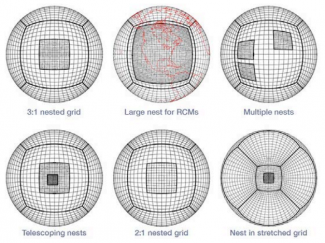DTC Article on NOAA Community Modeling Workshop and SIP Working Group meetings
The NOAA Community Modeling Workshop and meetings of the Strategic Implementation Plan (SIP) Working Groups were held 18-20 April 2017 at the National Center for Weather and Climate Prediction in College Park, Maryland. The goal of the meetings was to seek engagement with the Earth system science community to form and shape the nascent unified modeling community being built upon the Next Generation Global Prediction System (NGGPS), and to consider how to best execute shared infrastructure, support, management, and governance. Other topics addressed include identifying “best practices,” discussing how a community-based unified modeling system will actually work, and to evolve and coordinate between SIP/NGGPS Working Groups (WGs). A complete set of documents for the meeting, including the agenda, participant list, presentations, and summary reports are found on the workshop webpage: https://ral.ucar.edu/events/2017/community-modeling-workshop. For more information on the SIP effort, see the “Director’s Corner” article in the Winter 2017 issue of DTC Transitions.
The NOAA Community Modeling Workshop, which ran from 18 April through noon on 19 April, was designed to interact with the broader model R&D community. As such, this portion was completely open to the public, and included a dial-in capability for the plenary sessions. The opening talks set the stage by describing the approach and goals of the Next Generation Global Prediction System (NGGPS), and a summary of the SIP and its goals and objectives. These opening talks were followed by a panel discussion of senior leaders from the weather enterprise, including the Directors of NWS and NOAA Research, UCAR President, and senior leaders from academia, private sector, NASA, National Science Foundation, and DoD (Navy). Each were asked to provide their perspective on three items:
- What aspects of a NOAA-led community to develop next-generation unified modeling system would your organization and sector find advantageous? In other words, how do you think your organization/sector would benefit?
- For which parts of a community unified modeling effort would your organization or sector be best able (and most likely) to contribute? In other words, what do you feel is the best role for your organization/sector to play?
- From the perspective of your organization or sector, what do you see as the greatest challenges to be overcome (or barriers that must be broken down) to make this a successful community enterprise?
The remainder of the presentations were panel discussions featuring co-chairs from 12 active SIP WGs, each of whom provided their perspective on the ongoing activities of their WG and the overall effort to migrate the NGGPS global model, under development within NOAA, into a community-based unified modeling system.
The workshop concluded on the morning of 19 April with a series of parallel break-out groups, each of which was asked to provide their assessment based on what they saw and heard during the presentations to identify two categories of items:
- Best practices: What are the major things that we’re getting right?
- Gaps: What are the major things that we’re missing, or heading down the wrong track?
Note: Reports from these breakout sessions can be found in the workshop summary.
The SIP Working Group meeting, which ran from the afternoon of 19 April through the end of 20 April, consisted of a series of meetings between the various SIP Working Groups (WG) aimed at advancing the technical planning within each WG and ensuring that this technical planning is well-coordinated across WGs. These meetings, also referred to as Cross-WG meetings, were also designed to identify areas of overlap vs. gaps between the WGs, and to help facilitate technical exchange.
Each WG was asked to provide (1) an overall assessment of the effectiveness of the workshop, (2) a summary of “immediate needs” they felt needed to be worked ASAP to ensure success in the long term, and (3) items on the “critical path” that were most important upon which others depended. A summary of the “immediate needs” and “critical path” items are provided in the SIP meeting summary, which includes the full reports from each WG.
The overall consensus of the meeting participants for both portions of the workshop was very positive, with the most common feedback noting the increase in transparency within the Environmental Modeling Center and NOAA at large, the increasing effort to engage the entire community, and the general sense of positive momentum of the community coming together to embrace the opportunity to use NGGPS as a foundation to build a true community modeling resource for the Nation.
